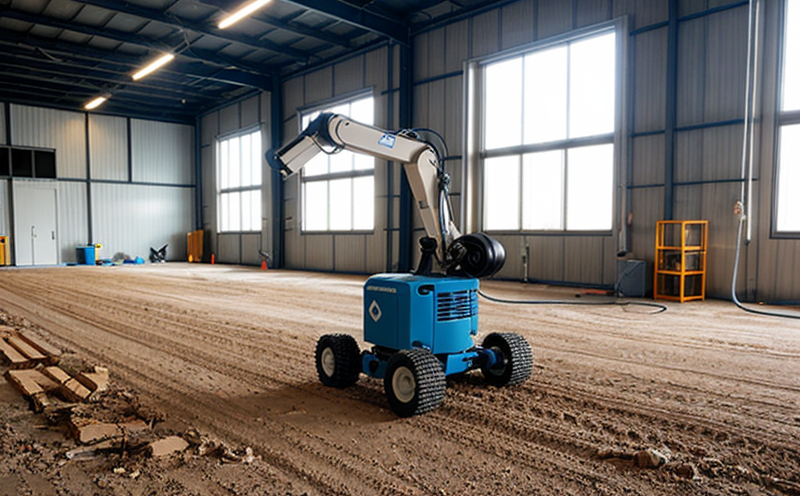IEC 60068-2-52 Salt Mist Corrosion Testing of Robotics Components
The International Electrotechnical Commission (IEC) standard IEC 60068-2-52 defines the test conditions for salt mist corrosion testing. This particular test is crucial for robotics and artificial intelligence systems, especially those deployed in environments with high humidity or exposure to salty air, such as coastal areas, marine applications, and industrial settings.
The purpose of this test is to evaluate the resistance of materials and components used in robotic systems against corrosive environments. Salt mist testing helps manufacturers ensure that their products can withstand harsh conditions without degradation, thus extending product life and reliability. By adhering to IEC 60068-2-52, companies can enhance their reputation for quality and compliance, which is essential for maintaining a competitive edge in the global market.
The test involves exposing specimens to a controlled salt mist environment. The apparatus used for this test typically includes a chamber that can simulate various environmental conditions, including temperature, relative humidity, and salt concentration. The specimen is placed within this chamber, where it remains for a specified duration under strict conditions.
During the test, the exposure time of the specimens to the salt mist is critical. According to IEC 60068-2-52, the duration can vary based on the specific requirements and standards set by manufacturers or regulatory bodies. The temperature during testing also plays a significant role; it should be controlled within a narrow range to ensure consistent results.
The acceptance criteria for this test are stringent and involve visual inspection of the specimens before and after exposure. Any visible changes in color, texture, or presence of corrosion on the surface can indicate inadequate resistance against salt mist. Additional tests may include electrical conductivity measurements or mechanical strength assessments depending on the specific components being tested.
Robotic systems that undergo this type of testing are expected to perform reliably under challenging environmental conditions. This is particularly important for applications such as drones operating near coastlines, industrial robots handling corrosive chemicals, and autonomous vehicles navigating through salty roadways during winter months. By ensuring compliance with IEC 60068-2-52 standards, manufacturers can enhance the durability and longevity of these systems.
Another critical aspect of this testing is the preparation of specimens before exposure. Proper specimen preparation ensures accurate and reliable test results. This includes cleaning the surface thoroughly to remove any contaminants or residues that could interfere with the test outcome. Additionally, protective coatings or treatments applied prior to testing should be considered in accordance with industry best practices.
It’s important to note that while IEC 60068-2-52 provides comprehensive guidelines for salt mist corrosion testing, it does not cover all possible environmental factors that might affect a robotic system. Manufacturers must consider additional tests or adjustments based on specific application requirements and operating environments.
In summary, adherence to the IEC 60068-2-52 standard is vital for ensuring robustness and reliability of robotics components in corrosive environments. Through rigorous testing, manufacturers can enhance product performance, meet regulatory standards, and build consumer confidence. Proper specimen preparation and strict adherence to test parameters are key factors contributing to accurate results.
Scope and Methodology
The scope of IEC 60068-2-52 salt mist corrosion testing encompasses the evaluation of materials and components used in robotic systems exposed to corrosive environments. The methodology involves creating a controlled environment within a test chamber where specimens are subjected to specific conditions over defined periods.
- Chamber Setup: The testing apparatus must meet specified dimensions and internal configurations as outlined in the standard. This ensures uniform exposure of all specimens within the chamber.
- Environmental Parameters: Temperature, relative humidity, and salt concentration are carefully monitored and controlled to replicate real-world conditions accurately.
The acceptance criteria for this test are based on visual inspections post-exposure. Any signs of corrosion or degradation in appearance should be noted and documented. Additional tests may include electrical conductivity measurements or mechanical strength assessments depending on the components being evaluated.
For specimens to undergo this testing, proper preparation is essential. Cleaning surfaces thoroughly ensures accurate results by eliminating any potential interference from external factors. Protective coatings or treatments applied before testing must align with industry standards and practices.
It’s crucial for manufacturers to understand that while IEC 60068-2-52 offers detailed guidelines, it does not account for all environmental variables affecting robotic systems. Therefore, additional considerations based on specific applications are necessary.
Eurolab Advantages
At Eurolab, our commitment to providing top-tier testing services extends beyond mere compliance; it includes ensuring that each test is conducted with precision and accuracy. Our state-of-the-art facilities equipped with advanced instrumentation guarantee reliable results every time.
- Expertise: With a team of seasoned professionals specializing in various fields, we offer specialized knowledge tailored to your specific needs.
- Comprehensive Testing: We cover all aspects of robotic component testing, including salt mist corrosion, ensuring no stone is left unturned during evaluation.
- Fast Turnaround Time: Leveraging our efficient processes and resources allows us to deliver quick results without compromising on quality.
The unique combination of cutting-edge technology, experienced personnel, and unwavering commitment to excellence makes Eurolab the go-to choice for comprehensive robotic component testing. Whether you are developing new products or ensuring existing ones meet stringent standards, our services provide peace of mind knowing that every aspect has been thoroughly examined.
Use Cases and Application Examples
- Marine Robotics: Drones used in marine operations must withstand saltwater immersion. Salt mist corrosion testing ensures their durability.
- Industrial Robots: Handling corrosive chemicals requires robotic systems to be resilient against environmental aggressions, making this type of testing indispensable.
- Autonomous Vehicles: Operating in salty road conditions during winters demands robust components that can endure harsh environments.
In addition to these examples, Eurolab also supports research and development efforts by providing precise data on material performance under various salt mist exposure levels. This information aids manufacturers in optimizing designs for better resistance against corrosion.





